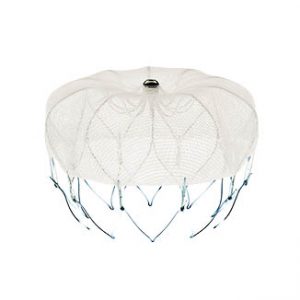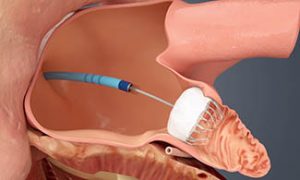WATCHMAN Left Atrial Appendage Closure
 Patients suffering from Atrial Fibrillation or AFib are at a much higher risk of suffering from a stroke. This is primarily due to blood pooling in the pouch-like Left Atrial Appendage (LAA). The WATCHMAN Implant is a quarter-sized device used to help prevent blood clots formed in the LAA from breaking loose and causing a stroke in patients with non-valvular AFib. An added benefit of this procedure is that the vast majority of patients (over 90% according to the PREVAIL clinical study) are able to reduce or eliminate their dependence on warfarin within just 45 days after implantation.
Patients suffering from Atrial Fibrillation or AFib are at a much higher risk of suffering from a stroke. This is primarily due to blood pooling in the pouch-like Left Atrial Appendage (LAA). The WATCHMAN Implant is a quarter-sized device used to help prevent blood clots formed in the LAA from breaking loose and causing a stroke in patients with non-valvular AFib. An added benefit of this procedure is that the vast majority of patients (over 90% according to the PREVAIL clinical study) are able to reduce or eliminate their dependence on warfarin within just 45 days after implantation.
How the WATCHMAN Implant Works
The WATCHMAN implant requires a procedure time of about 60 minutes and is performed in a minimally invasive manner at a hospital. During the procedure, your EP uses an IV like device called a sheath to place a catheter through a vein, into the heart and to the opening of the LAA. The WATCHMAN device is then deployed. The device looks much like a parachute or jellyfish and once in place, expands to form a framework for sealing off the LAA.
 Heart tissue is very adaptable and over the course of the next two to three months, tissue will grow around the special fabric coating of the WATCHMAN to form a complete seal at the entrance to the LAA. Because the heart’s own tissue is the primary sealing mechanism, the seal is not only effective, but permanent.
Heart tissue is very adaptable and over the course of the next two to three months, tissue will grow around the special fabric coating of the WATCHMAN to form a complete seal at the entrance to the LAA. Because the heart’s own tissue is the primary sealing mechanism, the seal is not only effective, but permanent.
Recovery time requires an overnight stay at the hospital and downtime is minimal, dependent on the patient’s health.
For the first 45 days or so after the procedure, patients will take blood thinners as the heart tissue will not have completed the seal and there is still a risk of stroke. After the 45 days, we verify the seal using a TEE or Transesophageal Echocardiogram to see that the LAA is fully closed off. Most people stop their blood thinner at this stage.
Benefits of the WATCHMAN Implant
- Does not require open heart surgery
- The minimally invasive nature of the WATCHMAN reduces recovery time with less risk of pain and blood loss and a shorter hospital stay
- The vast majority of patients eliminate their need for blood thinning medication
- The overall risk of stroke in non-valvular AFib patients is reduced significantly
- Proven, FDA-approved technology with 10 years of clinical testing and 15,000 implants worldwide
- A permanent, one-time treatment option
Risks and Considerations of the WATCHMAN Implant
- Some patients will have to remain on warfarin even after implantation
- This device does not prevent strokes originating in areas other than the LAA
- This device does not treat underlying AFib or arrhythmias
- Procedure specific risks can be found in the WATCHMAN patient guide, by clicking here
- Any invasive heart procedure comes with risk, which will vary between patients. These will be discussed during consultation
Not all patients will qualify for the WATCHMAN procedure, including those with an LAA that is too large or small to accept the device, those who may be allergic to device components or those who cannot take warfarin or other blood thinners. Those who have valve-related AFib will not be candidates for this procedure.
Those who do not qualify for the WATCHMAN procedure, but still wish to explore options other than medication to reduce their stroke risk, may be candidates for other LAA closure such as the minimally invasive LARIAT or surgically placed Atriclip.
The WATCHMAN is a revolutionary device that offers yet another option to those with a high risk of non-valvular AFib-related stroke.

